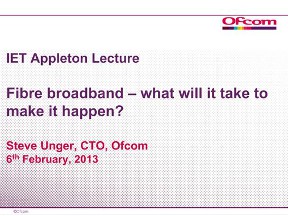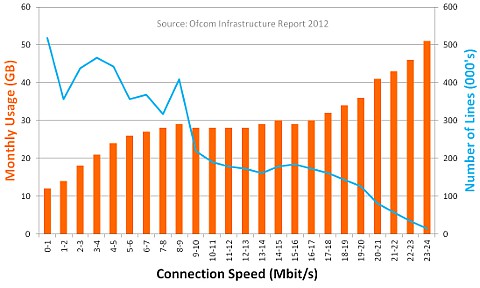Thursday 7 February, 2013, 13:15 - Much Ado About Nothing
Posted by Administrator
Posted by Administrator
 At the IET, Ofcom's chief technology officer, Steve Ungar, gave the annual IET Appleton lecture (parts of which can be viewed on the IET.tv web-site). The title of the lecture was 'Superfast Broadband - what will it take to make it happen', though the opening slide (shown on the right) suggested that Ofcom's views on superfast broadband are clearly that 'superfast equals fibre'. Whether or not wireless (eg LTE) or even satellite services could deliver superfast broadband was discussed in the question and answer session at the end of the presentation at which Dr Ungar indicated that, of course, both had a role to play. But the Freudian slip on the opening slide clearly shows in which direction Ofcom sees the future of high speed broadband.
At the IET, Ofcom's chief technology officer, Steve Ungar, gave the annual IET Appleton lecture (parts of which can be viewed on the IET.tv web-site). The title of the lecture was 'Superfast Broadband - what will it take to make it happen', though the opening slide (shown on the right) suggested that Ofcom's views on superfast broadband are clearly that 'superfast equals fibre'. Whether or not wireless (eg LTE) or even satellite services could deliver superfast broadband was discussed in the question and answer session at the end of the presentation at which Dr Ungar indicated that, of course, both had a role to play. But the Freudian slip on the opening slide clearly shows in which direction Ofcom sees the future of high speed broadband.This slip-up aside, one of the most interesting slides presented by Dr Ungar compared the connection speed that users enjoy with the amount of data they consumed. This diagram is reproduced below (the data is taken from Ofcom's 2012 Infrastructure Report. What it shows are some things that are obvious and others which maybe are not.

The obvious first:
- The chart shows that users with connection speeds of below around 5 Mbps do not consume as much data as those with faster connections. This is relatively obvious because the slower the connection, the lesser the ability to consume data. A user with a 1 Mbps connection would have to use their connection 5 times longer to download the same amount of data as a user with a 5 Mbps connection.
- The chart also shows that those who specifically elect to have a very high speed connection of over 16 Mbps consume more data than those with a slower connection. In effect, those who are paying for higher speed connections (which accounts for approximately 10% of all connections) are doing so because they actually want to use them.
What is not obvious and is quite surprising is that for those with connection speeds in the range of 6 to 16 Mbps, the amount of data they consume each month remains remarkably consistent (at around 28 Gbytes). Having a faster connection does not lead to using more Internet. It thus seems that there is a natural plateau of usage for an average user that is pretty consistent. And that plateau can be reached with a connection speed of 5 Mbps or greater.
Whilst the height of this plateau will inevitably rise as the number of connected devices in homes increases, it does suggest that, for today's British household, a connection speed of 5 Mbps or greater, with a data cap of 40 Gbytes per month (to allow for the occasional peak now and then) would satisfy around 90% of Internet users. Returning to the question of superfast broadband, it therefore seems somewhat gung-ho to be spending hundreds of millions of pounds investing in a fibre-based system which, even Dr Ungar admitted, would only ever reach around two-thirds of the population.
Terrestrial wireless networks (3G) can already deliver the kind of speeds required (HSPA+ offers connection speeds of up to 42 Mbps and even faster if MIMO antennas are used) and tariffs with unlimited data (subject to the usual fair use policies) can be had for around GBP20 per month. Even satellite broadband tariffs, often seen as uneconomical, can offer connection speeds of 20 Mbps with unlimited data download for around GBP35 per month. As things stand, both 3G and satellite networks can provide speeds and packages that exceed what Ofcom has shown to be the average requirement of a typical Internet user of today. As with all such technologies, as time progresses, they will improve and may well stay ahead of requirements.
 What Dr Ungar also pointed out was that the 'last few metres' of almost all Internet connections today are wireless, whether it is the few metres from the WiFi hub to the tablet, or from the cellular mast to the smartphone. To support the kinds of speeds likely to be necessary in the future, it is almost certain that fibre will be needed to deliver connections to wireless access points. In cities these are likely to be homes, streetlamps and anywhere else that a wireless hub can be located. Outside these areas, the availability of fibre will be sparse.
What Dr Ungar also pointed out was that the 'last few metres' of almost all Internet connections today are wireless, whether it is the few metres from the WiFi hub to the tablet, or from the cellular mast to the smartphone. To support the kinds of speeds likely to be necessary in the future, it is almost certain that fibre will be needed to deliver connections to wireless access points. In cities these are likely to be homes, streetlamps and anywhere else that a wireless hub can be located. Outside these areas, the availability of fibre will be sparse.But the good news is, that in rural areas, existing wireless technologies can already deliver the kinds of speeds and data packages that meet the needs of the everyday Internet user. The so-called digital divide between urban and rural areas can already be spanned using existing technologies and services (in fact even Ferrets can do it), all that's needed is for regulators to take a step back and recognise that superfast broadband is not always necessary and that, by association, fibre is not necessarily the solution to every ill. A more balanced investment strategy that takes into account the strengths and weaknesses of each of the possible Internet connectivity solutions, and levels the playing field between them, might yield much greater public satisfaction.
add comment
( 1659 views )
| permalink
| 



 ( 2.9 / 2085 )
( 2.9 / 2085 )




 ( 2.9 / 2085 )
( 2.9 / 2085 )

